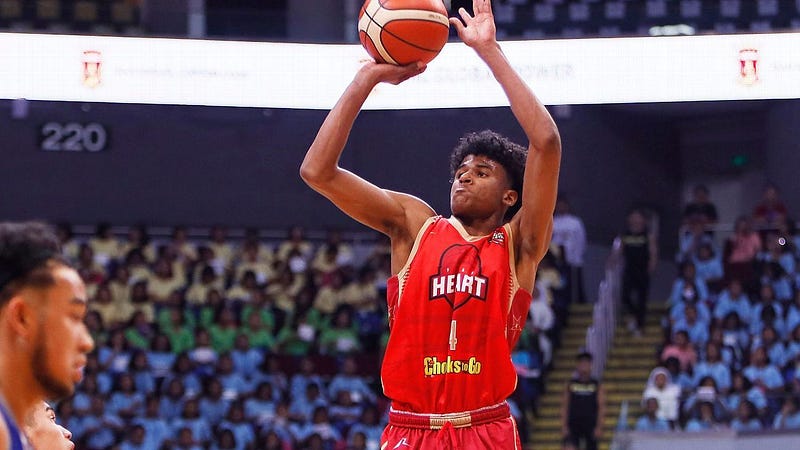
ESPN number one recruit Jalen Green’s decision to skip college and sign with the NBA G-League has raised questions about the future of the NCAA. Green signed a roughly $500,000 deal with the G-League. He is set to join “NBA G League Ignite,” a new, unaffiliated team whose goal is to prepare top high school athletes for NBA success. This team will include Green, as well as fellow blue-chippers Isaiah Todd, Daishen Nix, Jonathan Kuminga and Kai Sotto. Princepal Singh, an NBA Global Academy India graduate, will also join them. They will operate out of Walnut Creek, CA, and play against a variety of competition, including other G-League teams, international clubs, global NBA development teams.
This novel program aims to keep future lottery players from playing internationally pre-NBA. LaMelo Ball and RJ Hampton, two former high school stars, chose the Australian NBL instead of the NCAA or the G-League. While they both personally benefited from their decisions, they had to travel far from home. This complicated their NBA recruitment processes, forcing scouts to travel across the world to see them play. The new elite team looks to develop recruits domestically, promising them NBA exposure from the jump. Former Laker and 5x NBA champion Brian Shaw will coach the team. The team plans to also include NBA veterans who can guide these young players and help them attain an off-court lifestyle that promotes long-term success. The program will also incentivize the young players to attend community events and life skills programs, creating a more holistic pathway to bolster the basketball aspect of an NBA career.
The NCAA could experience some measurable losses from a growing G-League. Firstly, the loss of high-profile recruits translates to a loss in popularity, and therefore a loss in revenue (ticket sales, merchandise, etc.). For example, had Zion Williamson joined the G-League, the NCAA would have missed out on millions. Zion’s hype is generational, but similar players will follow. Bronny James and Mikey Williams are two high school juniors already generating social media followings that parallel Zion’s. If they, or others of similar status, skip out on college, the NCAA loses millions in potential profits. Additionally, if the issue of coronavirus persists, more athletes may choose the G-League as a safety measure to avoid a college lifestyle where coronavirus can spread easily. Ignite is also offering its prospects full scholarships to Arizona State University, an NBA partner school ; this eliminates the NCAA’s advantage of a college degree, an advantage that is already under scrutiny given the fact that that education plays a secondary role to athletics for top collegiate athletes. Overall, if the G League continues to grow and looks to become a farm-type program similar to the lower leagues of Major League Baseball, NCAA basketball could see a significant decline.
However, the NCAA will probably be fine, for now at least. Even if it misses out on 10–20 five-star recruits per year, these players do not mean everything to the NCAA; the competitiveness remains without them. If you look at the top seven teams in the AP top-25 last season, none of them had a player that would have received an elite G-League contract. Additionally, from 1995–2005, the best players in the country went straight to the NBA, and the NCAA still thrived. College sports are grounded in tradition, school spirit and financial systems; students and alma mater will continue to support their teams, local fans will continue to flock to games, and rich boosters will continue to help fund programs. Many players are also drawn to the NCAA over the G League because of this spirit. 20,000+ fans per game and national TV interviews are a significant selling point. This spotlight not only excites players, but prepares them for NBA life, where the cameras are always on. The current state of the G-League lacks this level of attention. Therefore, the NCAA maintains this important advantage.
A modified G-League could even benefit the NCAA if it chooses to adapt with it. Again, the objective of the G-League program is to give the top players in the nation an avenue other than one-and-done or overseas play. If this program works and grows, the one-and-done collegiate option may be removed. In that case, one-and-done caliber players will more likely elect the G-league. This could actually improve the integrity of NCAA basketball programs though. Top schools will attract more players who want to play four years and get an education, and they will not give out scholarships to players who only plan to be on campus for a season. In turn, schools can develop more devout followings, as the turn-over rate for players would be much lower. Star players would spend at least two years in the NCAA, and help foster loyalty and consistency among fans.
The NCAA will survive. It may lose top recruits, and money and hype along with them, but star players will still come to college, and the NCAA will continue to generate a tremendous fanbase. Additionally, the NCAA has begun initiatives to
allow players to get paid
for third-party endorsements of name, image and likeness. This shifting definition of amateurism could mix things up even more.
Again, things could change against the favor of the NCAA; Jalen Green and company could light up the league in future years, and devote their success to the G-League program, leading to the next generation of top high school players skipping college. However, this does not necessarily translate to the NCAA’s demise, as long as they prepare for it and change with it. For now, and for the foreseeable future, the G-League and college basketball can peacefully coexist.
















